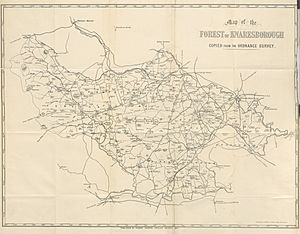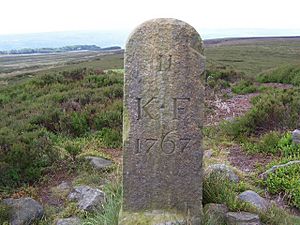Forest of Knaresborough facts for kids
The Forest of Knaresborough was a special area in Yorkshire, England. It was used by kings for hunting. This "forest" wasn't just a place with lots of trees. It was a large area of land with special rules to protect wild animals, especially deer.
It covered about 117 square kilometers (45 square miles). This land was west and south of the town of Knaresborough. It was located between two rivers, the River Nidd and the River Wharfe. Today, this area is part of North Yorkshire.
Contents
How the Forest Started
The Forest of Knaresborough probably began in the 1100s. The first time it was mentioned in records was in 1167. This was during the time of King Henry II.
Kings like Henry II and King John really enjoyed hunting here. Later, King Edward III gave this land to his wife, Queen Philippa. After she passed away in 1369, Edward gave it to his son, John of Gaunt. John of Gaunt was the Duke of Lancaster.
Since then, the Forest of Knaresborough has been owned by the Duchy of Lancaster. This is a private estate belonging to the British monarch.
How the Forest Was Managed
As mentioned, the Forest of Knaresborough was not just a big woodland. It was a hunting area with specific rules to keep game animals safe. People lived in villages and small settlements within the forest. They had farms and fields there.
The forest was first split into three main areas called "constabularies":
- Thruscross: This included places like Bramley, Darley, and Thornthwaite.
- Clint: This had five smaller areas, such as Birstwith and Hampsthwaite.
- Killinghall: This included Beckwith and Bilton-with-Harrogate.
Later, these areas were divided into eleven separate constabularies.
Deer Parks and Hunting Lodges
Inside the larger forest, there were two special fenced-off areas. These were called deer parks. They were named Haverah Park and Bilton Park. These fences were designed to let deer enter but not leave. This made it easier for the kings to hunt.
You can still see the remains of an old hunting lodge in Haverah Park. It is known as John O'Gaunt's Castle. In 1380, John of Gaunt ordered another hunting lodge to be built in Bilton Park. This building, now called Bilton Hall, was changed a lot in the 1800s.
Rules and Life in the Forest
People living in the Royal Forest had to follow special laws. For example, they were not allowed to hunt deer. They also couldn't use bows and arrows or hunting dogs. There were fines if they cut down trees without permission.
These people were like tenants of the king. But they had the right to live on their land and could even pass it on to their families. As long as they didn't bother the king's hunting, they were free to make a living. They farmed, ran mills, and even had other businesses. For example, there are records of iron forging (making things from iron) from the early 1200s. However, this industry slowed down later because too many trees were cut down to fuel the forges.
The Forest Changes Over Time
By the time of the Tudor kings and queens, the Forest of Knaresborough was not used for hunting as much. English monarchs spent less time hunting there. Many of the trees in the forest had been cut down. This was often to sell the wood for the iron smelting industry (melting metal).
A survey in 1604 found only 410 trees left in Haverah Park. King James I liked hunting and didn't want the forest to be cleared. But his son, King Charles I, did not feel the same way. In 1628, Charles I sold off both Bilton Park and Haverah Park.
The town of Harrogate grew within the forest area during the 1600s and 1700s. In 1770, a law called an Act of Enclosure divided the forest land. Some parts of the forest stayed with the Duchy of Lancaster. Some land was given to tithe owners (people who collected church taxes). A part of Harrogate became a public open space called The Stray.
You can still see some signs of the old forest today. There are many boundary stones that were put up in 1767. These stones mark the edges of the forest as they were back then.
Images for kids





